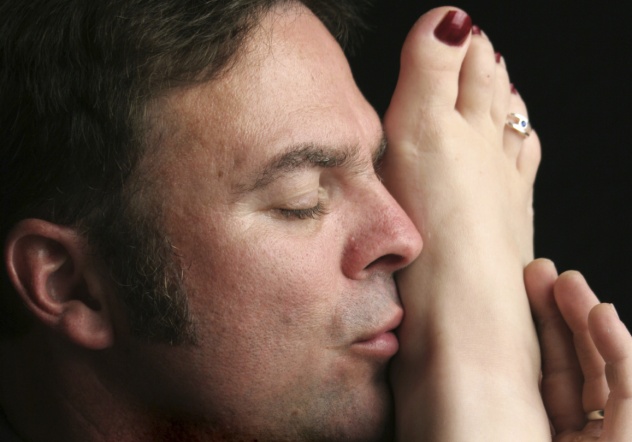 Creepy
Creepy  Creepy
Creepy  Technology
Technology 10 Scientific Breakthroughs of 2025 That’ll Change Everything
 Our World
Our World 10 Ways Icelandic Culture Makes Other Countries Look Boring
 Misconceptions
Misconceptions 10 Common Misconceptions About the Victorian Era
 Mysteries
Mysteries 10 Strange Unexplained Mysteries of 2025
 Miscellaneous
Miscellaneous 10 of History’s Most Bell-Ringing Finishing Moves
 History
History 10 Great Escapes That Ended Right Back in Captivity
 Weird Stuff
Weird Stuff 10 Fascinating Things You Might Not Know About Spiders
 Food
Food 10 Everyday Foods You Didn’t Know Were Invented by the U.S. Military
 History
History 10 Odd Things Colonial Americans Kept at Home
 Creepy
Creepy 10 More Representations of Death from Myth, Legend, and Folktale
 Technology
Technology 10 Scientific Breakthroughs of 2025 That’ll Change Everything
 Our World
Our World 10 Ways Icelandic Culture Makes Other Countries Look Boring
Who's Behind Listverse?

Jamie Frater
Head Editor
Jamie founded Listverse due to an insatiable desire to share fascinating, obscure, and bizarre facts. He has been a guest speaker on numerous national radio and television stations and is a five time published author.
More About Us Misconceptions
Misconceptions 10 Common Misconceptions About the Victorian Era
 Mysteries
Mysteries 10 Strange Unexplained Mysteries of 2025
 Miscellaneous
Miscellaneous 10 of History’s Most Bell-Ringing Finishing Moves
 History
History 10 Great Escapes That Ended Right Back in Captivity
 Weird Stuff
Weird Stuff 10 Fascinating Things You Might Not Know About Spiders
 Food
Food 10 Everyday Foods You Didn’t Know Were Invented by the U.S. Military
 History
History 10 Odd Things Colonial Americans Kept at Home
10 Psychological Perspectives On Sexual Fetishes
According to Freud, sexual fetishes were perversions caused by childhood trauma, and they could be remedied or alleviated by psychoanalysts for a reasonable fee. Modern research has turned away from this perspective, though the ultimate reason for the diverse range of different things that people find attractive is elusive. Evolutionary psychologists believe that this diversity in attraction helps to promote sexual stimulation and therefore the propagation of the species, regardless of the environment it finds itself in.
Some say that Freud may have been right after all, and the foundations of fetishes are indeed laid by childhood experiences and stimuli, though not necessarily trauma. The answer for the fetishes per se may be elusive, but studies on particular sexual fetishes have brought up a few interesting theories. While they may not apply to everyone who professes to a particular sexual fantasy, they are fascinating explorations of human sexual psychology.
10 Transsexual Fantasies

It is an odd fact that many men who identify themselves as straight admit to fantasies about either pre- or post-operative male-to-female transsexuals or male cross-dressers, while they have no attraction to homosexual or heterosexual men. This attraction is known as gynandromorphophilia, though it is usually expressed in crude pornographic terms as interest in “she-males,” “chicks with dicks,” or “lady boys.”
According to homosexual reporter Daniel Harris, who spent time as a drag queen, such an individual is easy to understand as “an opportunist who is willing to overlook the imperfections of the disguise for the sake of a good blow job, which he has heard through the sexual grapevine, correctly as everyone knows is more expertly administered by men than by women.”
There have been few studies on the phenomenon, though one by Northwestern University suggested that of the respondents who admitted to attraction to transsexuals, 51 percent identified as straight. While for many, the attraction to transsexuals manifested as a sexual desire separate from their heterosexuality, for some, it formed the central part of their sexuality. One study quoted a straight man with an interest in trans women, who attributed his attraction to “an exoticness, a uniqueness, something that can’t be obtained elsewhere. They’re just totally unique in their sexuality in that they’re both men and women and at the same time, neither men nor women. To me that’s my fascination.”
A large problem with the study of the phenomena is that many transsexuals rightly object to being classified as a “fetish object.” Trans blogger Sass expressed her disagreement with the way the discussion is framed: “The question shouldn’t be why these men are attracted to us, but why is society forcing us to justify this attraction in the first place. I feel the question arises because people have already pre-judged that being sexually or romantically attracted to people like me is perverted and immoral.”
While she is right that people shouldn’t have to justify their attraction to other consenting adults, it remains an interesting question in terms of the psychology of sexuality. According to research by Ogi Ogas and Sai Gaddam, the answer may lie in the effect that the penis has on the male sexual brain. Evolutionary psychology suggests the presence of an erect phallus can actually have stimulating effects on men, as it is associated with male-on-male aggression, territorialism, and attracting females. The combination of female secondary sexual features with the phallus may have the effect of activating primeval fight-or-flight responses and also orgasm via the sympathetic nervous system.
9 Rape Fantasies

Many studies have indicated that one of the most common sexual fantasies among women is the rape fantasy, a phenomenon that is rarely discussed due to the very real possibility that it will be used by foul individuals to justify actual rape, a horrifying and dehumanizing experience. An analysis of 20 studies conducted over 20 years have indicated that 37–51 percent of women have had such fantasies, and they’re regular or preferred for 9–17 percent.
According to research by Joseph Critella and Jenny Bivona, there are many (often contradictory) reasons for this fantasy: For a minority of women, it relates to masochism. Studies have linked societal sexual repression with such fantasies, indicating a desire to avoid sexual blame. Openness to sexual experience (a character trait) has been correlated. Although the evidence is inconclusive, it’s possible that some women view being raped as a sign of their irresistible desirability. Male rape culture (in other words, social pressure to buy into male fantasies) may be a factor. Some feel that women have a biological predisposition to surrender, which has been observed in other species but not empirically tested in humans. Being raped can activate the sympathetic nervous system (again, related to flight-or-fight responses and orgasm). Another cause may be the thought of adversary transformation, a “romantic” trope about “taming” men through sex. Still other possible reasons could be a reaction to trauma (a psychological defensive mechanism) or laziness (according to anecdotal reports).
A blogger under the pseudonym of Ranty McRanterson gave her experience:
I have the rape fantasy, I’m gonna come out and say it because I can actually explain it. It is incredibly common to sexualize fears. All kinds of fears. Just because I fantasize this doesn’t mean that I actually want it to happen. Think about it physically for a second, fear creates adrennaline, and adrennaline is exciting and that helps get you off pretty damn quick. It’s also common for sexually abused children to fantasize about rape as adults, does that mean they want to be raped? NO!
Professor Meredith Chivers has suggested that such fantasies may flourish through an absence of imagined negative repercussions, tapping into primitive sexual instincts while avoiding the reality of the trauma. The key issue that needs to be understood is that a rape fantasy is still a fantasy, which means it is a completely internal mental experience under the complete control of the person doing the fantasizing. Therefore, it stands in stark contrast to the violence, coercion, and loss of control in actual rape.
For that reason, some prefer to refer to them as surrender fantasies or “fantasies about being ravished.” Psychology professor Marta Meana, a self-avowed feminist, believes it comes down to the idea that for a woman, “being desired is the orgasm,” and that women’s desire “is not relational [but] narcissistic.” Thus, so-called “rape fantasies” aren’t about a secret yearning to be the victim of a sexual crime but rather a fantasy about willing surrender to a chosen partner, with the illusion of danger, while actual control still lies with the woman.
8 Vorarephilia

The sexual desire to eat another person or be eaten by another person violates one of humanity’s oldest taboos. It is known online as vorarephilia or simply vore. At best, it is a harmless fantasy expressed online or with a partner who is either similarly inclined or supremely tolerant. At worst, it can combine with unstable mental conditions and lead to murderous acts by individuals like German consensual cannibal killer Armin Miewes, Japanese murderer Issei Sagawa, or the highly disturbing creepiness of cannibal cop Gilberto Valle.
The fetish is often linked with other related fetishes, such as masochism, hypoxyphilia (suffocation fantasy), snuff (fantasy about watching another die or to be killed), or macrophilia (attraction to giants). There are many variations of the theme online, such as hard and soft vore (the former involving violence and gore, the latter involving a person being ingested whole), as well as varieties where people are ingested via the penis, vagina, anus, or breast.
The main issue arises within the difference between vorarephilia, which is usually fantasy-based and relatively harmless, and sexual cannibalism, which can manifest as a psychosexual disorder which, in certain individuals (like sociopaths), can lead to horrific murders. Pure fantasists of vore or cannibalism are the ultimate expression of sadomasochistic urges, with the predator dominant and the prey submissive. But for those with other psychological conditions, the desire can lead to murder, especially if their fetish is linked with erotophonophilia (aka lust murder), involving the sexualized murder and mutilation of a victim.
Oddly, convicted sexual cannibals are not always necessarily psychotic or otherwise immoral. According to Psychology Today, when one cannibal was accused of rape, he was indignant: “I may kill them and eat them, but I never raped anyone! You make sure people know that!” Another was asked why he had asked his victim what his favorite dishes were, and the offender replied, “I wouldn’t want to insult him by cooking him the wrong way.”
7 Cuckolding

Traditionally known as troilism, cuckolding is a fetish in which a man derives sexual pleasure from watching or merely knowing about his wife or partner having sex with another man. Often, the pleasure is linked to the other man being a better lover or better endowed, which is why cuckolding has been linked by some to masochism, due to the humiliation factor. Dan Savage argued that cuckolding is the eroticization of male anxiety about their partner cheating on them.
Some believe that the fetish is actually linked to a phenomenon known as sperm competition. When a woman has sex with multiple men, the men exhibit (often unconscious) changes in behavior and biology designed to increase their likelihood of fertilizing an egg. Their sperm count goes up, and they tend to thrust deeper and harder during sex. On the other hand, one psychologist blames “king bee syndrome,” in which men gain psychological gratification from the idea of other men wanting to sleep with his partner.
Some argue that cuckolding is a fetish that appeals to the highly educated and intelligent, to whom cuckolding represents a form of psychological sadomasochism that arouses through mental anguish. This argument is presented by a man with cuckold fantasies who happens to have a PhD, so it could be taken with a grain of salt, but cuckolding-related sex therapist Susan Brock theorizes along similar lines.
She claims that competition for a female stimulates sexual desire and performance, because nature naturally tends toward laziness unless there is a compelling reason to up one’s game. The argument is that most modern men are unable to enjoy such fantasies because of jealousy, which stems from archaic concepts about “owning” one’s wife, while intellectuals can get past the jealousy response and reap the benefit of the sexual thrill caused by competition.
Rachel Uchitel, who was engaged in an extramarital affair with Tiger Woods, reported getting an email detailing the golf star’s cuckolding fantasy, which read:
“I had a dream we were married and I was leading the tournament. I came home, excited to see you, and there you were in the bedroom getting f—ked by Derek [Jeter] and David [Boreanaz]. Some part of me thinks you would like that. Now I can’t get back to sleep. My body is tired, but my mind is awake. Need an Ambien.”
6 Foot Fetishism

Attraction to feet and footwear is surprisingly common, being the most fetishized of all non-genital-related body parts or clothing. Freud believed that humans sexualized feet because they resemble penises . . . somehow. University of California San Diego neuroscientist Vilanayar Ramachandran has another intriguing possibility.
Ramachandran was researching the brain phenomena that can cause phantom limb syndrome and discovered it was likely caused due to the “body image map.” The parts of the brain that are associated with and control different parts of the body stayed active even if those parts had been lost. Bizarrely, he discovered that for some foot amputees, the body image map could actually become rewired and sexualize the missing limb, explaining reports by amputees of sexual pleasure and orgasms from their phantom feet.
It has long been noted that in the somatosensory homunculus, a visual expression of where touch is processed by the brain, the area associated with the feet and toes is adjacent to the area associated with the genitals. Ramachandran thought this could explain the common foot fetish: “Maybe even many of us so-called normal people have a bit of cross-wiring, which would explain why we like to have our toes sucked.” Not everyone was a believer, however. Discover Magazine‘s Neuroskeptic pointed out the feet and toes were the least erotic parts of the body. Quentin Tarantino, for one, might disagree.
5 Tentacles

Japan is notorious for erotica involving tentacles, animated or otherwise, and it appears to have a surprisingly long history. The first appearance was in an early 19th-century shunga (“spring picture”), a form of erotic painting popular in the Edo period. One of the most renowned shunga artists was named Hokusai, who painted the famous Great Wave, as well as the notorious The Dream of the Fisherman’s Wife, which depicts a woman having sex with two octopi. Thus began a long and storied history of sexualized cephalopods, though the notion of “tentacle rape” may be of recent vintage. According to Dr. Danielle Talerico, “Japanese audiences of the Edo period would have associated [Hokusai’s painting] with consensual sex.”
Some claim that censorship may actually have spawned the interest in tentacle porn. In the early 1900s, in order to improve their image, Japan banned uncensored porn unless it was intended for immediate export. These laws stayed in place throughout the 20th century, preventing genitals from being visible in Japanese erotica. In 1986, manga artist Toshio Maeda circumvented these laws with the movie Urotsukidoji, which involved supernatural beast sex in which penises were replaced by things resembling them, most notably tentacles. In the aftermath of Urotsukidoji‘s success, many other imitators have followed.
Some believe that the phenomenon has a deeper and more worrying significance. Dr. J.P. Dahlquist and Dr. L.G. Vigilant claimed:
The experience of hentai is morally distancing. Tentacle hentai offers the telegenetic signs of the most perverse and debased sexualities. It opens for fantastic examination a sexuality that transgresses all “simulated” moralities of the “real” world, where tentacle sex between nubile girl-women and cloned boy-men monsters are the order of the day—a monstrous sex-feast of the most abnormal acts: pedophilic bestiality, sex with machines, sex with cyborgs, sex with dangerous protruding tentacles, and, of course, an endless stream of the most debasing, brutal, and humiliating rape images.
4 Vampires

While the eroticization of blood-sucking immortals has reached new heights in recent years due to Twilight and True Blood, the phenomenon has been well-known in Western culture for a long time.
Some see the reason behind it in evolutionary psychology, particularly in the desire for a mate who can provide and care for children. Vampires are usually portrayed as tall, handsome, virile, wealthy, and powerful, signaling good genes and high levels of testosterone. The fact that they are unpredictable and supernaturally powerful activates the brain’s reward system, releasing dopamine. Another factor is that vampires are inhuman and therefore “forbidden love,” which again releases dopamine, which is associated with focus and goal-seeking. Rutgers University’s Helen Fisher even argues that it may be that women with high levels of estrogen are more likely to be attracted to portrayals of high-testosterone men, even if they’re dead and drink human blood.
Donovan Gwinner, who teaches a class on vampires in popular culture at Aurora University, believes that there may be an economic link to the attraction to vampires: “In times of economic contraction, fear of job loss, and war, the vampire myth really speaks to people. What’s so bad about being powerful, almost immortal, always in control, and incredibly desirable?” Meanwhile, DeSales University psychology professor Katherine Ramsland spent several years researching vampire lore obsessives and came to the conclusion that it was all about the erotic appeal of danger and death:
It’s kind of like autoerotic asphyxia, except that’s real. In terms of fantasy, the vampire mystique is 90 percent sexual. It’s a metaphor for dangerous sex. Because if it goes wrong, you’re gone.
3 Paraphilic Infantilism

Infantilists are those who derive pleasure and stimulation from dressing or acting like babies, which may involve wearing diapers or baby clothing, drinking from a bottle, crawling on the floor, being spanked, or similar behaviors. Online communities engaged in this paraphilia are divided into the adult babies (ABs), who enjoy the role-playing aspect, and diaper lovers (DLs). They’re collectively known as the ABDL community.
The Fourth Edition of the Diagnostic and Statistical Manual of Mental Disorders (DSM-IV) classified this fetish with masochism, but if elements of humiliation or suffering are not present, then it doesn’t exactly meet the criteria. It has been linked to a range of other paraphilias (odd sexual desires), including sexual transvestism (in this case, dressing as a baby of the opposite sex), urophilia and coprophilia (sexual pleasure from urinating or defecating into diapers), and lactophilia (breast-feeding). There is little to no correlation between infantilism and paraphilia, as adult babies aren’t attracted to children; they just want to be children.
There is no general consensus on what causes the development of the actual infantilism fetish, but it is believed to be linked with maladaptive learning and faulty imprinting in childhood as well as erotic targeting errors. However, for some, the sexual element is played down, with a greater emphasis on the nurturing and attention-seeking side of pretending to be a baby. A recent study has suggested that the paraphilia develops at around age 12 in women and age 17 in men. While various behaviors were present in both genders, women tended to prefer role-playing elements such as playing with baby toys or sexual or nonsexual play with a “daddy” figure, while men were more likely to use diapers. While there was a tendency for women with the fetish to have suffered childhood abuse (though not always), this was rare in male adult babies.
One of the reasons why so little is known about paraphilic infantilism is that many practitioners feel it does not cause them any functional distress or impair them in their everyday lives. This would mean that for most people, it would not be classified as a paraphilic disorder.
2 Somnophilia

This fetish involves arousal at the idea of caressing, touching, and engaging in sexual activity, without force or violence, with a person who is asleep or unconscious. Some have referred to the condition as pseudo-necrophilia. In 1972, Dr. Victor Calef and Dr. Edward Weinshel called it “Sleeping Beauty syndrome” and suggested that patients who complained about their partners falling asleep before sex could be initiated were actually covering up a deep-seated sexual fascination with their sleeping partner.
In a 2006 thesis on sleep, Christina Eugene wrote: “Sleep is the essential objectifier of all life. The passivity of sleep transforms subjects into inanimate objects, and in doing so removes the subject’s privilege of being able to act on the world of objects. [ . . . ] This rendering of people into inanimate objects allows them to be fundamentally treated as objects—consumed, fetishized, and controlled.” In another thesis, Carolyn Fay wrote, “Contemporary sleep fetish culture is driven by the idea that the sleeping person is an absent person. [ . . . ] To the fetishist, sleep is that perfect moment when consciousness is evacuated, leaving a living, breathing fragment, worthy of love. [ . . . ] If the person wakes up, the fantasy and the fetish object become lost.”
This particular paraphilia became newsworthy following the many allegations of sexual assault raised against Bill Cosby in 2015. The fallen actor is alleged to have drugged and raped multiple women since the 1970s, using Quaaludes and Benadryl. Some witness testimony, including women who had consensual sex with Cosby, seems to confirm this. But in legal and moral terms, connecting the two is a distraction, as it is just as likely that Cosby used the drugs merely or primarily to prevent the women from resisting his sexual advances.
1 Strabismusophilia

The name of this particular fetish, which is admittedly rare, was coined by Dr. Mark Griffiths for his blog, where he discusses the psychology of paraphilia. (While Griffiths is a professor of gambling studies, his amateur musing on fetishes is well-researched and interesting.) Strabismus is the condition of having misaligned eyes, and thus strabismusophilia is an attraction to people who are cross-eyed. What makes this interesting is some that this attraction actually led to some of the earliest musings related to paraphilias.
French philosopher Rene Descartes had an attraction to cross-eyed women, which apparently began with a childhood infatuation with a girl who was mildly cross-eyed. While at the time, he loved her in her entirety, later in life, he found himself more attracted to other women with the same condition, though it took him a while to put two and two together. On one occasion, Queen Christina of Sweden asked the philosopher what causes people to love one person more than another before they know anything about their relative merits. According to a 2011 paper by Alex Voorhoeve:
Descartes replied that when we experience a strong sensation, this causes the brain to crease like a piece of paper. And when the stimulus stops, the brain uncreases, but it stays ready to be creased again in the same way. And when a similar stimulus is presented, then we get the same response, because the brain is ready to crease again. And what did he mean by all this? Well, he gave an example. He said that all his life he had had a fetish for cross-eyed women. Whenever he came across a cross-eyed woman, desire would enflame him. And he figured out after introspection, that this was because his brain had been strongly creased by his first childhood love, who was cross-eyed.
This is very similar to the Pavlovian concept of conditioning as an explanation for the rise of sexual fetishes. While strabismusophilia may not be so common, other eye-related paraphilias (oculophilias) have been documented, such as eyeball licking. Dr. Ruth Neustifter gave an explanation for that one in an online article:
Eyeballs are covered in naturally salty water used to keep them lubricated and clean, which also gives them a distinctively smooth and salty flavour. While the eyeball doesn’t feel in the same way that our fingers and tongue do, it can sense pressure and temperature, making eyeball licking an optimal form of stimulation. Pretty much everyone recognizes the eye as a vulnerable area of the body, making it an intimate area for some people. Where there is vulnerability and intimacy, you might just find eroticism! Some folks enjoy doing the licking, both for the sensation and for the ability to enjoy their partner’s vulnerability in this way. And for those who like to be licked, they find the situation as well as the physical stimulation to be highly enjoyable. This isn’t a universal erogenous zone, so many folks won’t get the attraction even if they try it.
David Tormsen has an uncontrollable attraction to the comments section. Email him at [email protected].







